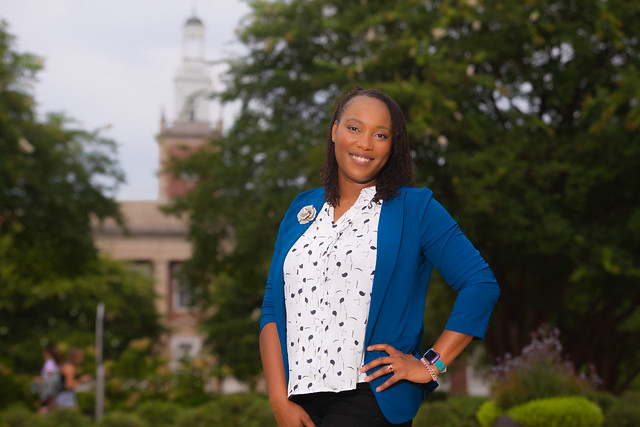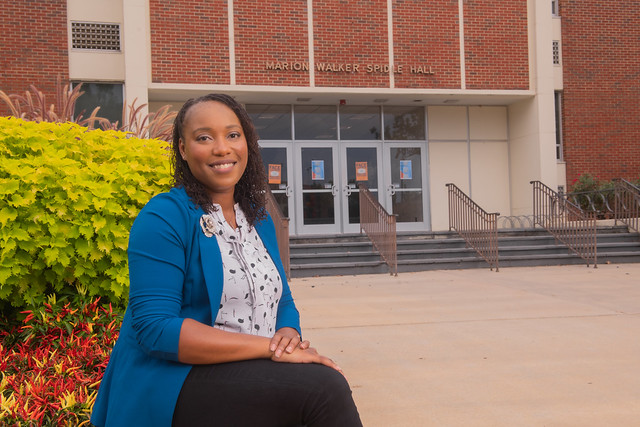Albert shares wealth of passion, practice with Auburn interior design students
Article body
Taneshia W. Albert has been changing perspectives all her life.
She convinced her family that interior design was a better career choice for her than being an attorney. She persuaded contractors and architects to consider her expertise and, together, they reshaped a New Orleans hospital ravaged by Hurricane Katrina. After consulting for a Black-owned architectural firm in St. Louis, she was inspired to enter academia and encourage young people to reflect their power and value in their designs.
“To me, teaching is an extension of practice,” said Albert, an assistant professor of interior design in Auburn’s College of Human Sciences. “Good design helps you be more of who you are, and I want to make our students more capable than they think they are. That is my purpose.
“They are my little social justice warriors, and they are going to go out and make our world better.”
The American Society of Interior Designers, or ASID, has taken notice of Albert’s career and named her to its 2021 Ones to Watch program award winners, an honor bestowed on only 20 interior design professionals. She is one of only two academics on the list and one of eight award winners to be recognized as a Ones to Watch Scholar.
Albert, who came to Auburn in 2019, called it an amazing honor and “insane” to be recognized by ASID and “even crazier” to be on its Scholars List. The distinction means she gets to participate in a two-year leadership development training program.
According to ASID, scholars first learn to leverage and embrace their unique perspectives and backgrounds to excel in their careers, and then transition to thought leaders and subject matter experts by creating learning content and serving as mentors to the next class of ASID Ones to Watch Scholars.
Albert is the first person at Auburn to earn the recognition since ASID started the program in 2017.
“It’s a great thing for them to do, but I don’t see myself as a leader. And in academia? What? It can’t be,” said a positively skeptical Albert.
But then a grateful Albert realized the Ones to Watch program is meant to recognize industry professionals who, as ASID says, “represent authenticity, innovation, leadership, inclusion and a dedication to the profession. The society prioritizes participants whose backgrounds are currently under-represented in management roles within the interior design industry, including women, members of racial and ethnic minority groups, LGBTQ and persons with disabilities.”
“I am pleased to see that a professional design organization is telling others to open their eyes and see us,” said Albert. “It’s great for ASID to recognize and lift us up.
“It’s what Pam [Ulrich] and the Auburn interior design faculty do for me now.”
Giving credit
Albert gives much credit to her new colleagues, most of whom she has only known for two years, one of which was under quarantine because of the COVID-19 pandemic.
She was well-acquainted with one person, however. Lindsay Tan, the W. Allen and Martha Reimer Reed Associate Professor, met Albert when the two were in the same master’s program at Florida State University.
The pair have collaborated on research projects for some time, including their recent work on the Slave House on Goree Island, which was published in the “Journal of Interior Design.”
Albert had met some of the faculty at a conference not long ago. Although she remembered feeling instant chemistry with them, she didn’t consider joining their team.
However, after much prodding from Tan, Albert applied. When she interviewed with Ulrich, head of the Department of Consumer and Design Sciences in the College of Human Sciences, she told her she should not hire her.
Albert confessed to being a difficult employee, who is hard to manage because she will push her students and herself.
“I cannot sit still. My eight hours every day have to matter for something,” she said. “I work and think at a different pace, and I won’t take no for an answer. Some may find that hard to handle.”
Turns out, that kind of resolve is a trait Albert was born with and one Auburn is happy to have.
Pride of the family
Albert grew up in California after her family left the south region as part of the Great Black Migration. At seven years old, she was certain she would grow up to be a lawyer. She said she knew the U.S. Constitution and legal jargon, unlike the rest of her peers, because she spent much time after school at the law school library in the Oak Park region of Sacramento.
With the family’s approval, Albert worked hard in school and decided to attend Dillard University back in New Orleans. She studied international business, Spanish, public policy and finance.
During her junior year, Albert participated in a fellowship program with the Institute for International Public Policy, a part of the United Negro College Fund Special Programs Corporation, so she could work as an international corporate attorney, helping Spanish-speaking countries get out of debt.
The program is aimed at addressing minority and diversity recruitment in global affairs.
Between time at Clark Atlantic University and the University of Maryland, Albert had a revelation.
“It really did start me thinking about policy, how it relates to everything, even design,” she said. “It changed my life.”
When Albert studied abroad in Spain, she first recognized the connection between architecture and the self, and how design could connect with a community. This convinced her to pursue interior design.
Albert graduated from Dillard as planned in 2005—becoming the first person in her family to become a college graduate—but her future would no longer involve the law.
She joked that her decision did not exactly sit well with the family. They considered it foolish to give up a promising legal career “to fluff pillows for the rest of your life,” she said.
Albert would eventually prove them wrong, but with a college degree and no job, she was not sure how to start this new journey.
Changing plans
Fortunately, she found a program at Florida State that helped people without a bachelor’s degree in interior design acquire an advanced degree in the discipline. The program no longer exists, but it helped Albert earn a Master of Fine Arts in interior design.
By the time she finished, Albert was married with a child. Another degree and no job, she stayed at FSU and volunteered for no pay, helping the leasing department convert old drawings into computer-assisted design. She would also assist the design and construction area of the facilities department.
Eventually, because of the quality of work she did, they created a paid-contract position for her. The experience led to a full-time interior design position at the Library of Congress in Washington, D.C.
Albert later returned to New Orleans as an interior designer at Ochsner Health Systems, working on their largest project at the time—moving their women’s and infant services to Ochsner Baptist Hospital, which was still significantly damaged from Hurricane Katrina.
She worked together with hospital staff, construction workers and local architects to establish a facility that met the varying needs of staff, patients and visitors. They even established an alternative birthing unit in the Orleans Parish hospital.
Albert said she learned about everything in the hospital—from anesthesia to surgical units to where bodies and supplies are stored—to be the best designer possible.
“A construction document is essential, but do the plans work? A half of a second in a space like this can be the difference between life or death,” she said.
“I was hired to see it all.”
Albert was primed to utilize the new birthing unit herself, but about a month and a half before her second child was born, the family moved to St. Louis, Missouri. A firm had recruited her to be a design director.
That move lasted about 18 months, when a former FSU professor and mentor encouraged Albert to apply for a teaching job at Illinois State University in Bloomington-Normal. Just as she accepted the new role, she joined WA Architects Inc. in St. Louis as a consultant.
Albert worked for the Black-owned firm until the assistant professor job started and beyond. She said the experience opened her eyes further to the struggles of Black architects and designers than any experience she had.
“I hadn’t seen lot of Black architects or designers before, not even in school,” she recalled. “It was really amazing to work at WA and see others like me.”
WA Principal Wade Price became an unknowing mentor, encouraging Albert to explore the design and architecture of St. Louis and learn what had been done by those who came before her.
“It was everything for me to learn from him,” she said. “You don’t think about yourself in design until someone tells you to think about yourself, your cultural background and how it pushes your design perspective. You also realize how alone you are until you are no longer the only one.”
In the classroom
Albert may have felt a little out of place teaching—she had some experience as a graduate teaching assistant—but she relied on her personal and professional experience to inspire her students to be competent and capable in their work.
“My job as an educator is not to shove stuff down their throats, but to help them build their toolbox,” she said.
Albert had moved to St. Louis several months before Michael Brown, an unarmed Black teen, was shot and killed by a white police officer in nearby Ferguson, Missouri, in 2014. The incident was still on her mind when she began teaching in 2016.
“I encouraged my students to open their eyes and see the world around them,” she said.
Albert was again challenged when she was faced with the death of her mother in 2016 and mother-in-law two years later. She coped by remembering all the “strong Black women” who supported her in her life and used their wisdom to inspire others.
Albert came to realize that, besides many strong Black women, there were certain people throughout her career whose mentorship shaped her into the woman she is today. As part of the Ones to Watch program, Albert will be a mentee and a mentor.
“I believe in mentorship,” she said. “Right now, Veena [Chattaraman] is my mentor. She is everything I want to be when I grow up.”
Chattaraman is a colleague and professor with the apparel merchandising, design and production management program in the Department of Consumer and Design Sciences.
“She is shaping my career, making me stronger and stronger in academia,” Albert said. “If I can do for someone else what she has done for me, then I can sleep well at night.”
Related Media
Media interested in this story can contact Communications Director Preston Sparks at (334) 844-9999 or preston.sparks@auburn.edu.
Auburn University is a nationally ranked land grant institution recognized for its commitment to world-class scholarship, interdisciplinary research with an elite, top-tier Carnegie R1 classification, life-changing outreach with Carnegie’s Community Engagement designation and an undergraduate education experience second to none. Auburn is home to more than 30,000 students, and its faculty and research partners collaborate to develop and deliver meaningful scholarship, science and technology-based advancements that meet pressing regional, national and global needs. Auburn’s commitment to active student engagement, professional success and public/private partnership drives a growing reputation for outreach and extension that delivers broad economic, health and societal impact.






